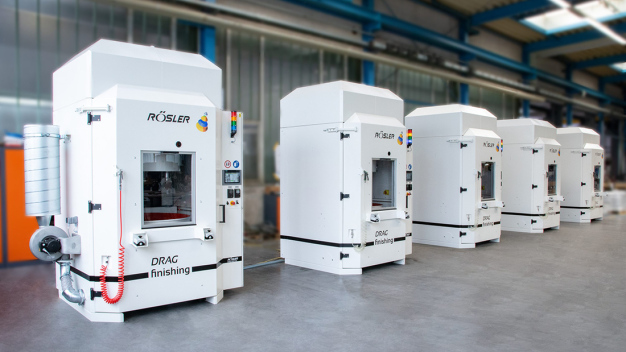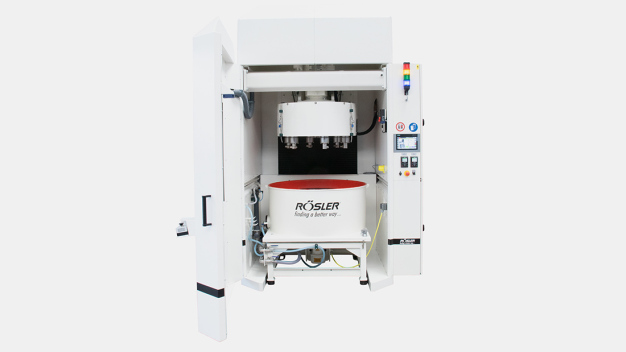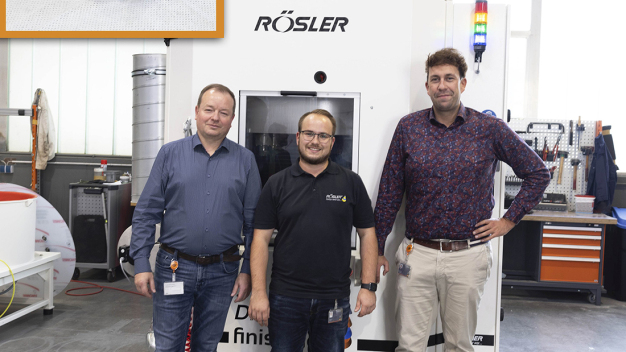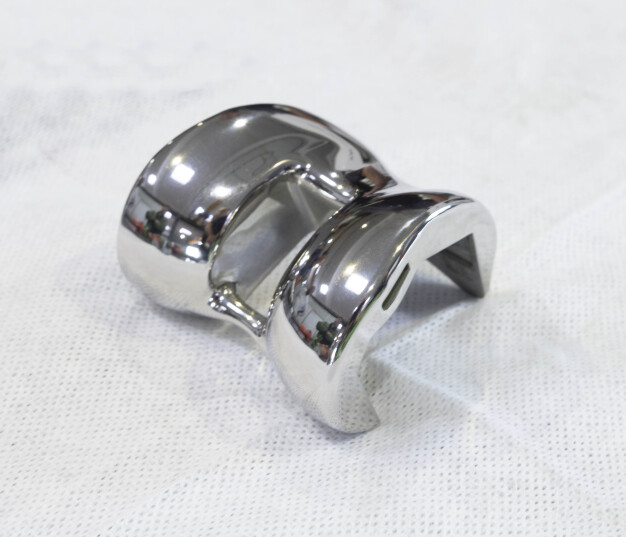- Facilities
Targeted surface finishing of femur components with high process stability and increased productivity
New Smith+Nephew plant employs Rösler equipment
To function properly and last for a long time in the human body, orthopedic implants require precisely defined finishes on different surface areas. For the targeted surface finishing of femur components in its new high-tech plant in Malaysia Smith+Nephew is utilizing two manufacturing cells, each containing three R 6/1000 SF drag finishers from Rösler. Two fully automatic Z1000 centrifuges, equipped with the digital process water management system “Advanced” from Rösler Smart Solutions, ensure that the process water is reliably and efficiently cleaned and recycled. Another indispensable contribution towards the stability of the finishing operation is the continuous monitoring and classification of the grinding and pre-polishing media.
The mission of Smith+Nephew, a globally leading medical technology company, is to replace defective body parts and, thus, improve the quality of life for the patients and extend their life expectancy. The company employs around 18,000 people in more than 100 countries. With the development and application of innovative technologies they work diligently to improve the products of the company’s three global business divisions “orthopedic reconstruction,” “modern wound care management” and “sports medicine.” This commitment to excellent medical solutions is reflected in Smith+Nephew’s new high-tech plant in Penang, Malaysia. The new plant, as part of the “orthopedic reconstruction” division, produces primarily endoprosthetic knee and hip implants.
Optimal surface finishes – a key quality criterion
Jürgen Preiser, senior manufacturing engineer at Smith+Nephew explains: „For each of our implants we have specifications that precisely define the required quality of their surface finish. In the new Penang plant he is coordinating the establishment of the surface finishing manufacturing cells for the knee implants made from cobalt chrome alloys. For example, the inner surface areas of femur components must have a precisely defined surface roughness to promote optimal integration into the bone. On the other hand, the outer surface areas must have a very smooth, polished surface finish to prevent friction causing premature wear. Therefore, some targeted outer surface areas of the femur components must undergo an extremely demanding finishing operation with absolutely consistent results.
Drag finishing – the solution for targeted surface grinding and polishing with no part-on-part contact
For this demanding task the customer chose the Rösler R 6/1000 SF drag finishers. These are special mass finishing systems that were developed for the precise and targeted surface finishing of high-value and delicate work pieces with complex shapes. Extremely important is that the femur components do not touch each other during the surface grinding and polishing operation. All process parameters, precisely adapted to the stringent finishing requirements, are stored in the PLC control panel. This guarantees absolutely repeatable and consistent results. Jürgen Preiser explains the decision for Rösler as follows: „Since our plant in Memphis, USA, is using identical finishing processes and machines for the same application, we have plenty of experience and know-how. This facilitates and expedites the approval for the respective equipment and finishing processes significantly. Another point in favor of Rösler was the company’s global presence with, for example, a distributor in Singapore. Moreover, Rösler develops and produces all its products in-house. This allows the optimal adaptation of equipment and consumables and guarantees a stable source of supply.
Two manufacturing cells – each containing three drag finishers
To date the plant on the Malayan peninsula is equipped with two manufacturing cells. Each cell contains three drag finishers for the process stages pre-grinding with ceramic media, pre-polishing with plastic media and dry polishing with a specially prepared organic polishing medium. To prevent any disruptions of the surface finishing operation, all drag finishers can be used for running the dry polishing process. Furthermore, four of the six drag finishers are suitable for the pre-grinding and pre-polishing as well as the dry polishing operation.
Optimized work piece clamping system results in 50 % higher work piece throughput
The drag finishers consist of a processing bowl with a diameter of 1,000 mm and a carousel with six rotary spindles. These are equipped with specially designed work piece fixtures, to which the femur components are mounted. The design of the fixtures allows clamping of the work pieces in a position that allows the finishing of precisely defined surface areas. A redesign of the fixtures now allows to increase the number of femur components clamped to one fixture from two to three without jeopardizing the all-around treatment and finishing quality. Jürgen Preiser comments on this design change enthusiastically: „We are now able to process 18 femur components in one single batch compared to only 12 we processed in the past. This increases our throughput by around 50 %, a truly remarkable boost of our productivity”.
During the start phase of the grinding and polishing process the rotating carousel is lowered. This causes the work pieces attached to the rotating spindles to be immersed into the media contained in the stationary processing bowl. The built-in immersion depth control system ensures that the specified immersion depth for the various work piece types is precisely maintained. Separate, independently controlled carousel and spindle drives allow the optimal adaptation of the processing intensity to the various femur types. The Rösler drag finishers, including the drives for the carousel and spindles, are very sturdy by nature. Therefore, no design change was necessary to cope with the higher operating load caused by clamping three work pieces to a spindle instead of two. Achieving all processing parameters, including the immersion depth of the work pieces, was no problem whatsoever.
Monitoring of the media level and media classification guarantee good finishing results
When it comes to consistently achieving high finishing qualities, maintaining the optimal media fill level in the processing bowl and the optimal media operating mix is extremely important. The media level is monitored visually as well as with special sensors. A message is displayed in the control panel, whenever an action by the operator is needed. “In addition, to maintain a consistently high finishing quality, we installed a media classification system, consisting primarily of a vibratory screening unit. Once per week we pass the ceramic and plastic media through the screening unit, where all undersized media are discharged from the operating mix“, comments Jürgen Preiser.
Digital process water management system improves overall process stability
For cleaning and recycling of the process water from the “wet” pre-grinding and pre-polishing operations in the two manufacturing cells Smith+Nephew purchased two fully automatic Z1000 centrifuges. Jürgen Preiser explains: „The dual centrifuge concept allows us to operate two separate process water cycles, one for the finishing operations with ceramic and one for the operations with plastic media. Maintaining two separate water cycles helps us prevent all kinds of problems, for example, foaming issues.” The control panel of each centrifuge is equipped with the digital process water management system from Rösler Smart Solutions. This innovative, interactive software allows the monitoring, data collection and evaluation of up to 14, individually selectable, process parameters. These include the compound concentration, pH value and microbiological contamination. The parameter target values and their respective tolerance range are stored in the software, and the actual values are entered for comparison purposes. Whenever one or several parameters are drifting out of the pre-defined range, the system displays an error message and issues easy-to-understand recommendations allowing a quick return to the specified tolerance range. This ensures a consistent high quality of the process water. Jürgen Preiser comments: „With the digital management system we not only control the process water cleaning and recycling operation a lot better. In addition, it helps us with the training of those employees who know very little or nothing about how to handle the process water.” Moreover, the recording of the parameters over a longer time period helps identify long-term trends in the process water so that necessary process water changes can be precisely scheduled with minimal disruption of the manufacturing operations. The digital process water management system also significantly reduces the consumption of compound and fresh water. And finally, the careful recording of all relevant water parameters represents an excellent tool for documenting the process quality and stability for quality audits and documentation purposes.
Jürgen Preiser summarizes: „The first two manufacturing cells are currently undergoing the mandatory validation phase. The start of full-scale production is foreseen in spring 2023. At the moment we are planning two additional manufacturing cells for the same products and finishing processes.”
Rösler Oberflächentechnik GmbH
96190 Untermerzbach
Germany












